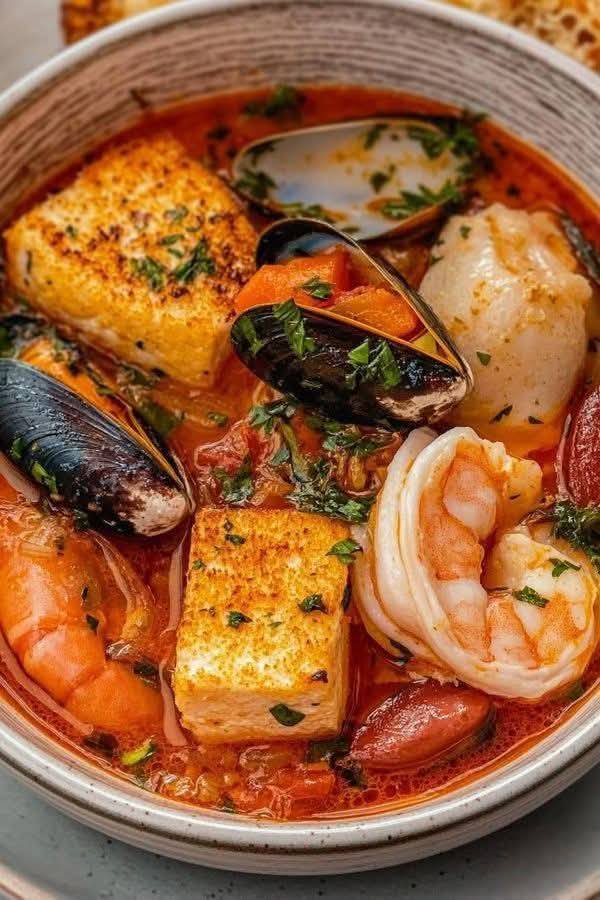Here is a classic recipe for Bouillabaisse, the iconic Provençal fish stew from Marseille. This recipe respects its traditional roots while providing clear, step-by-step instructions for the home cook.
Classic Bouillabaisse 🐟🦐
Bouillabaisse is more than a soup; it’s a ritual. It originated with Marseille fishermen who would make a stew from the bony rockfish they couldn’t sell. A true Bouillabaisse is characterized by its distinct broth, flavored with saffron, fennel, and orange zest, and is traditionally served in two courses: the broth first with toasted bread and rouille, followed by the fish.
Ingredients
For the Broth (The Foundation):
-
2-3 lbs (1-1.5 kg) assorted fish bones and heads (non-oily fish like snapper, sea bass, monkfish. Ask your fishmonger)
-
1/2 cup olive oil
-
1 large onion, sliced
-
1 large leek (white and light green parts only), sliced
-
1 small fennel bulb, sliced (fronds reserved for garnish)
-
4-5 cloves garlic, crushed
-
1 tomato, chopped
-
1 strip orange zest
-
1 tbsp tomato paste
-
1/2 cup white wine
-
1 large ripe tomato, grated (or a 14oz can of whole peeled tomatoes)
-
1 sachet (bouquet garni): 3-4 sprigs fresh parsley, 2 sprigs fresh thyme, 1 bay leaf, tied together
-
Large pinch of saffron threads
-
1 tsp fennel seeds
-
Salt and peppercorns to taste
-
8 cups water (or light fish stock if you have it)
For the Fish and Seafood:
-
1.5 lbs (700 g) firm-fleshed fish fillets (monkfish, sea bass, halibut, cod), cut into large chunks
-
1/2 lb (225 g) shellfish (mussels and/or clams, scrubbed)
-
1/2 lb (225 g) crustaceans (large shrimp/prawns, langoustines, or crab pieces)
For Serving:
-
Thick slices of crusty bread (baguette), toasted
-
Rouille (see recipe below)
-
Grated Gruyère cheese (optional, but traditional)
Quick Rouille Recipe
A garlic and saffron mayonnaise.
-
In a mortar and pestle, crush 2 garlic cloves and a pinch of saffron threads into a paste.
-
Whisk in 1 egg yolk and 1 tbsp of lemon juice.
-
Slowly drizzle in 3/4 cup olive oil, whisking constantly until thick and emulsified.
-
Season with salt and a pinch of cayenne pepper.
Instructions
Part 1: The Essence – Making the Broth
-
Prepare the Base: In a large, heavy-bottomed pot (like a Dutch oven), heat the olive oil over medium heat. Add the onion, leek, fennel, and garlic. Cook gently for 8-10 minutes until softened but not browned.
-
Build Flavor: Add the tomato paste and cook for 1 minute. Pour in the white wine and let it reduce by half. Add the grated tomato (with its juices), orange zest, bouquet garni, fennel seeds, and saffron. Stir well.
-
Simmer the Bones: Add the fish bones and heads to the pot. Cover with water (or stock). Bring to a boil, then immediately reduce to a low simmer. Skim off any scum that rises to the top. Simmer gently, partially covered, for 30-40 minutes.
-
Strain: Strain the broth through a fine-mesh sieve into a clean pot, pressing on the solids to extract all the liquid. Discard the solids. You should have a rich, aromatic broth. Season well with salt and pepper. (This broth can be made a day ahead.)
Part 2: The Final Stew – Cooking the Seafood
-
Bring to a Boil: Bring the strained broth to a rolling boil over high heat. This is where the name comes from: “bouillir” (to boil) and “abaisser” (to reduce).
-
Cook in Stages: Add the chunks of firm fish first. Cook for 3-4 minutes.
-
Add Shellfish: Add the clams and mussels. Cook for 2-3 minutes.
-
Add Crustaceans: Finally, add the shrimp/prawns. Cook for another 2-3 minutes, until all the shellfish have opened and the shrimp are pink. Discard any mussels or clams that do not open.
-
Serve Immediately: The key is to not overcook the seafood.
Part 3: The Ritual – Serving
-
Traditional Two-Course Service:
-
First Course: Ladle the flavorful broth into bowls. Serve with thick slices of toasted bread slathered with rouille and sprinkled with Gruyère cheese if using.
-
Second Course: Present the cooked fish and seafood on a large platter for everyone to admire, then serve it onto plates with a little more broth.
-
-
One-Course Service: For a simpler approach, ladle the broth and seafood directly into large, deep bowls. Serve with the toasted bread, rouille, and cheese on the side.
Key Tips for an Authentic Bouillabaisse
-
The Fish is Key: Use at least three different types of fresh, firm-fleshed fish. Rockfish like rascasse (scorpionfish) are traditional but can be hard to find.
-
Saffron is Non-Negotiable: It provides the signature golden color and flavor.
-
Don’t Skip the Rouille: This spicy garlic mayonnaise is an essential part of the experience.
-
The Boil: The rapid boil in the final stage is crucial for emulsifying the oil and broth, creating its unique texture.
-
Freshness: Every ingredient must be impeccably fresh. This is a dish that cannot hide poor-quality seafood.
Enjoy your journey to the coast of Provence! Bon appétit.
